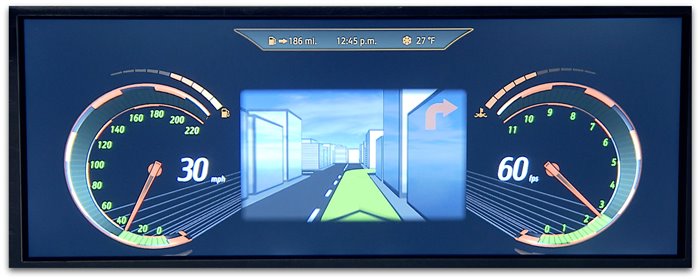SSZTBW2 november 2015 DRA744 , DRA745 , DRA746
What’s the relationship between Archimedes (287 BC – 212 BC) and 19th-century engineer Otto Schulze? Key elements of the modern instrument cluster are their groundbreaking inventions such as the odometer and speedometer that are the corner stones of every dashboard equipping your vehicle. It’s hard to imagine a car without both instruments today. This year, 2015, the speedometer turns 113 years. One should not be surprised that the odometer quickly got the attention of Roman generals during the First Punic War in 264 BC to optimize walking and rest time of their legions, no comment.
If the type of indications that speedometers do not differ much from first ones introduced 110 years ago. The trend toward more infotainment in the cockpit, combined with the availability of System-on-Chips (SoCs) such as the “Jacinto 6” family of infotainment processors (DRA7xx), are about to revolutionize instrument panels and a strict separation between driver/vehicle relevant information in the cluster and infotainment information in the center console will almost be no longer possible.
In future systems, not only will drivers rely on the instrument cluster to give them reliable vehicle information such as speed, engine RPM and fuel-level, but they will also expect:
- Full-color HD displays to perform the tasks of traditional analog instruments, with the ability to morph size, shape and colors according to the task at hand and driving priorities
- In addition to the standard gauges and needles, more complex content to be seamlessly blended, including media selections, 3D navigation and augmented reality views
- New ergonomics made possible by digital cluster to further improve their focus and attention on the road, including augmentation with Head-Up Display (HUD) to show relevant driving information in the driver’s direct field of vision
- Ultimately, display in the center field of vision relevant contents according to current driving situation

The above describes what we call reconfigurable digital instrument clusters which have virtually endless display possibilities. The “Jacinto 6” family is well suited to power such instrument clusters with its powerful architecture delivering high-level of graphics and robustness with software architecture capable of ASIL-B safety certification. It includes:
- High performance 3-D graphics processor, capable of driving fluid, delay-free animation and photo-realistic graphics to HD resolution displays at over 60fps
- ARM® Cortex®-A15 core(s) for the ability to run cluster processing functions in separate virtual machine from the Infotainment system
- ARM Cortex-M4 cores to be used as independent layer / display control for the instrument cluster
- C66x DSP for instrument cluster video watchdog
In addition to the above, the ability of “Jacinto 6” family GPU to perform powerful rendering features such as dynamic lightning, cube and sphere environment mapping, texture atlas, geometry morphing or reflective sky boxes will help to enhance the cluster display and reduce CPU load for these advanced effects.
After successful ramps in the head-unit and infotainment systems demonstrating the performance and scalability of the “Jacinto 6” platform, we at the TI Automotive Processors group are excited today to extend the scope of the platform and cannot wait to fuel innovation in the digital instrument cluster space.
The right timing matters and that’s certainly what Archimedes’ fellow countryman and Greek soldier Pheidippides, who ran between Marathon and Athens in 490 BC, would have think, as no one new at that time he covered the now well-known distance of 42.195 kilometers that we now refer to as the marathon.